DUNGLASS CASTLE AND HOUSE, near Bowling
ACCESS : Restricted.
B listed.
Also see the HENRY BELL MONUMENT, DUNGLASS CASTLE
Also see DUNGLASS CASTLE MAY 2025
As you turn off the A82 for Bolwing at the Dunglass roundabout or pass along the cycle track, you will notice some severe looking security gates and a gatehouse. These are here for a good reason - this has been a fuel depot. Unfortunately this completely restricts access to this striking combination of rocky promontary, Dunglass Castle and Henry Bell monument. In recent years the whole larger area has been transferred to the West Dunbartonshire Council. Substantial remedial works have been done the fuel depot area and work is soon to be commenced on infrastructure to enable it to be utilised for commerce and industry. The section of the site with the castle remains secured off this and will be the subject of a separate conservation / development exercise.
But there are ways to see it from a distance. It is partially visible through the trees, but an even better view is from the other side of the Clyde at low tide. To do the latter, go over the Erskine Bridge and turn immediately left down to the old ferry point and Boden Boo carpark. From there walk westwards under the Erskine Bridge until you are opposite the monument and castle. Quite a diversion and only practical at very low tide (take care), but you can actually get reasonably close to it.
What a way to see an important local historical site. So why is it of significance?
THE CASTLE
While it appears fortified, a castle, it is in fact a combination of ancient and more recent.
The date of the building of the castle is ambiguous. The listing text by HES tells us : The old castle dates back to 1380, when it was the important strategic stronghold of the barony of Colquhoun. But was it built by the Colqhouns or begun someone before them? it is certainly an imposing and strategic location and could have had something even earlier on it. The Romans are very likely to have used it to some extent as a lookout post, their fort at Old Kilpatrick being very close by.
The County of Dunbarton The Third Statistical, Account of Scotland notes the following:
In the early thirteenth century the west part of the present parish was granted to Humphrey de Kilpatrick; the name of this land Colquoun, was applied to Humphrey's descendents, one of whom aquired the lands of Luss by marriage. They had a castle on the site of the present Middleton Farm, but later owned Dunglass Castle, the date of which is sometimes put as early as 1380. It features several times in national history, and to-day its ruins stand on the bank of the Clyde in a commanding position west of Bowling.
In his book (see reference below), John Bruce mentions this too, but puts doubt on the authenticity of that date. He however similarly notes that it was one of the residences of John Colquhoun, Chamberlain of Scotland from 1439 until 1478. After his death, it passed to his widow, Elizabeth Dunbar, Countess of Moray. In 1489 the Royal Army occupied the castle while besieging that of Dumbarton, which was held against James IV, by the sons of Lord Darnley. John Bruce notes the efforts to recover houses and castles from the rebels in the west, of which this area was part. Dunglas Castle thereby played a role. The following comes from the accounts of the Lord high Treasurer (As quoted by John Bruce. The author's own words are in italics and the words that he in turn quotes are in inverted commas).
"After the reduction of Duchal and Crookston the siege of Dumbarton made little progress through relays of the feudal army had succeeded each other. Fresh levies were therefore summoned from the west and south to assemble at Glasgow moor, and on the 18th October the king proceeded to press the siege in person. The besieging force having been driven from the shelter of the town, had fallen back upon Dunglass castle, about 3 miles from Dumbarton castle, which repaired and strengthened, was made the base of operations. Here the chief officers of state were in camp, each having a certain number of men, for whome wages were received from the Treasurer, and hither materials for the siege were wuickly collecte, the great gun Duchal being brought from Arkil near Paisley, and boats, conveyed overland, from Daldres (Grangemouth) and Blackness.
"Messengers were in the meantime gathering in the contributions granted by the 'kyrkmen' for the wages of Dunglass, and summoning fresh levies. The castle of Dumbarton surrendered early in December, and the same year, 1489, the king kept Yule at Edinburgh".
It then seems to have little prominence for some time, but in the 17th century appears to regain its military significance.
Again refering to John Bruce's book : After the memorable conflict of Glenfuin in 1663, the dispositions of various persons were taken in the presence of Alexander Colquhoun and a Notaty Public at Dunglass. The castle of Dunglass, though less important for military purposes than the castle of Dumbarton, which from its strong situation by nature afforded great advantage for attack and defence, was yet, from the position of commanding the passage of Clyde, regarded as no small military importance, and in times of civil commotion each of the conflicting parties was eager to possess it.
In terms of strategic location, it would have equalled Dumbarton in the way it jutted out into the main shippign route - the Clyde. Dumbarton was almost impregnable due to its steep and high rock faces. And it had rivers on twwo sides and marsh on the others. Dunglass by comparison lacked these natural barriers except to the south, but it did have fairly extensive and almost flat land surrounding it on which troops, their horses and supplies could be used to muster.
The following entry appears in the Memorabilia of the City of Glasgow Council records (fol. 106):-
"16th 1640. The said day ordains John Kirkwood to goe out with the companie who are direct for ane recrew to Capt. Porterfield and to convey to Dunglass to the armie".
The Covenanters, in their struggle with Charles First, having gained possession of the castles of Dumbarton and Dunglass, garrisoned and provisioned them in order to strengthen themselves against Montrose, who, with unremitting efforts, was endeavouring to collect the northern cans around the royal standard. In 1646, in the month of June, General Leslie, on behalf of the Lords of the Covenant, garrisoned the castle with an ensign, a sargent, and thirty privates.
The surrender of Dumbarton and Rossdhu castles to Oliver Cromwell, in 1652 and 1653 respectively - the latter belonging to the Colquhoun family, who stoutly fought against the famous Ironsides - was the last occurence of any military importance on the Clyde, and judging from the measure of retribution dealt out on similar occasions we may safely infer that Dunglass castle owes its ruinous state to Oliver's soldiers.
Canmore notes a Cromwellian Fort slightly to the west under what has been oil tanks and subsequently redeveloped. That record is based on a reference by Horsely, but gives no further details. See link below. Perhaps it was something basic to serve the troops camped there.
Dunglass Castle did get military there again, but this seems to have been more as a place to meet. There were still sizeable level grounds and these were used as a place to muster the military. One such occasion was then they saw off the remains of the Duke of Argyll with some ceremony in 1703 before his internment in Kilmun.
John Bruce writes : When the castle of Dunglass fell into ruinous state it sustained great injury, not only from being entirely neglected, but from wanton destruction. In the year 1735, when the taste for preserving ancient ruins had hardly any existence, the Commissioners of Supply for the County of Dumbarton recommended some of the freestone of the old ruinous house of Dunglass to be used in repairing the quay there at the expense of the county. This Gothic barbarity continued to be ruthlessly perpetuated under various pretexts while the castleand lands continued the property of the Edmontstones of Duntreath, who acquired them in 1732; but in 1812, Andrew Buchanan of Silverbanks acquired by a feudal disposition from Sir Charles Edmontstone the farms and lands of Dunglass, Littlemill, castle and shore thereof, for a payment of a feu duty of £5 sterling yearly, and at once put a stop to the destruction of the castle, partially restored what remained of it. The only portions of the old castle now remaining are thesouth-west wall next the Clyde, and the north-east wall with a doorway. On the south-east side of the west wall was a battery full of arrow holes, which commanded the river. This battery fell into the Clyde on the night of the 23rd March 1823, during a terrific gale.The conical dovecot to the east of the battery is still entire (at the time of writing in 1893), and it, along with the building on the west, forming the lower portion of the tower, evidently belongs to the 16th century. The form of a shield rudely carved on the northern turret seems to belong to that period. The initials V. C. may be those of Sir H. Colquhousn who was killed at the battle of Banachra. It is said the original stronghold of the Colqhuouns sood near Middleton farm, Milton of Colquhoun, an old building still standing on the eastern slope of Dumbuck hill being still known as Colquhoun house, and that its stones were employed to be the castle of Dunglass.
John Bruce, writing in 1893, continues the discussion on Dunglass with some interesting observation of this building as well as those of the associated surrounding area.
So here we have a castle at an extremely strategic point on the Clyde being used as a base for operations against the more predominent one at Dumbarton. Remember that this was a small stone castle on a promontory, The grand house had not yet been built - we will come to that in a moment. It may not have had its own grand history, but it did play an important historical role in a secondary way. The HES listing text notes that: In the early 18th century it fell into neglect and was partly dismantled for the restoration of the Bowling quay. This was halted by Andrew Buchanan of Auchentorlie, who bought the property in 1812... The north west turret has chequered corbelling and bears the Colquhoun arms along with other devices, whilst the round south east turret is probably 17th century in date and may have been a pigeon roost.
THE HOUSE
The castle took on new historical significance when graphic artist Talwin Morris occupied it. By this time though, what is referred to is actually a large house built on the promortory, not the castle itself. Quite when the house was built is also unclear. The castle was occupied as a residence by the Colquhouns and was probably modified over time to make it more homely. In due course this was replaced by a substantial and dignified house, paintings from the 19th century aparently showing it incorporating some original castle walls to the sides.
The first specific mention of a house is by Fraser (writing in 1869) when Sir Humphresy Colquhoun was killed at Bannachra in 1592. The suggests that the style of the house is that of the 16th century. It was apparently much remodelled in the subsequent centuries.
Wiki notes : Responding to an advert of 1 March in the Glasgow Herald, he and Alice leased Dunglass Castle from July 1893 and began to design its interiors. Morris is also known to have been a keen collector of Martinware ceramics, a passion he shared with his cousin Ernest Marsh. Bookplates designed by Talwin and Alice at that time are generally thought to reflect the circumstances of their new home and life together. The house was sold in July 1899 to the parents of his friends Margaret and Frances Macdonald, and Morris's interiors were subsequently completely remodelled by Mackintosh.
Talwin Morris certainly had a great influence on the form of the house that we see today. He was a prolific book designer and decorative artist working in the late 19th and early 20th centuries, particularly known for his Glasgow Style furniture, metalwork and book designs. He became the graphic designer for Glasgow publishers Blackie and Son. With Morris being a leading artist within the Glasgow circles at the time, he was naturally close to others including "The Glasgow Four". These included the painter and glass artist Margaret MacDonald, acclaimed architect Charles Rennie Mackintosh (MacDonald's husband), MacDonald's sister Frances and Herbert MacNair. It was through this close network that Mackintosh got the commission from Blackie for Hillhouse in Helensburgh. Morris had asked Mackintosh to design the castle interiors.
For an idea of what the interior looked like with Mackintosh's contribution, refer to the University of Glasgow link in the references below.
Strangely, although listed "B", the official listing text give almost no detail about the grand house, instead refering mainly to the original castle ruins. This is certainly an oversight on the part of those who listed for Historic Environment Scotland. But we can see from the photos below that it was sizeable and quite elegant with great views over the Clyde.
The castle and the large house that took on its name have both been abandoned for a very long time and have become derelict. Fortunately some years ago work was done on the roof of the house in an attempt to preserve the building, although it remains on the Buildings at Risk Register for Scotland. The original castle can still be made out, but only a few stone walls remain standing. As for the house, some fittings had been removed years before. The castle's bookcase is now in the collection of the Royal Museum, Edinburgh. The premises have been out of bounds to the public for many years, but local history enthusiasts were able visit it about 20 years ago. (see the photos at the end). They found the place a sad shambles. One of them ran his hand across a shelf and found five loose panels. They had feint artwork on them so expert advide was sought. They appear to have been by Talwin Morris and were placed in the care of West Dunbartonshire Council.
THE FUTURE
The whole area is currently the subject of redevelopment proposals for industry and commerce with a new spine road between Bowling and Dumbarton east. As at 2024 this work is well advanced. These premises incorporating the promontory with the house, castle ruins and Bell Monument will be covered by a separate consultation. The potential for restoration of the house and suitable landscaping of the surrounding area including the castle remains and the monument is well recognised, but may well prove to be some time in the future.
Dunglass Castle itself is an important historical feature within West Dunbartonshire. The manor house has world-wide significance through its direct associations with the art of the late 19th and early 20th centuries that we know as the Glasgow Style.
Add to that the Henry Bell Monument and the rocky promontory overlooking the Clyde and you realise that his area has great potential as a tourist attraction and as a local place for recreation. A means of revitalising the immediate area.
Now imagine the manor house restored and adapted to new use. An arts centre with studios, classes and shops. A restaurant. Accommodation, perhaps as budget hostelry. That will require sufficient parking and safe access. The proposals at this point in time refer to footpaths and cycle ways as well as landscaping. A new spine road will reach from the crossing of the railway line at the current security point through to Dumbarton. A good start, but just a start. There may well be new industry and commercial premises on either side, but we need to allow for the future of the Dunglass Castle area to be fully provided for. This is the time to ensure that this is possible later. Opportunities must not be missed.
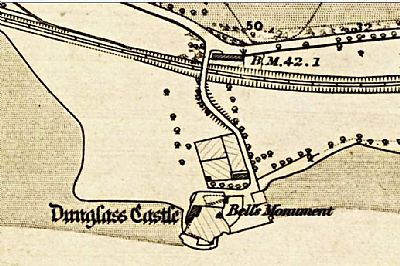
An extract from NLS map : Dumbartonshire, Sheet XXII
Survey date: 1860, Publication date: 1864 NLS © You can see the vegetable and fruit garden which appear to be walled and with an associated building. The road up to the main Dumbarton Glasgow road is much as it has been until lately when the whole area has undergone changes to make it suitable for industry. That intersection is now where Dunglass Roundabout now is.
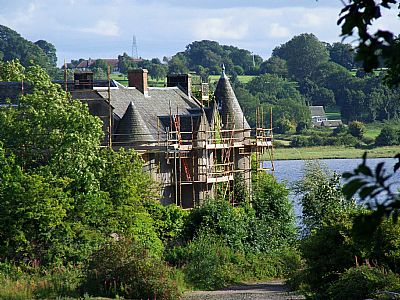
A rare glimpse through the trees while roof repairs were under way.
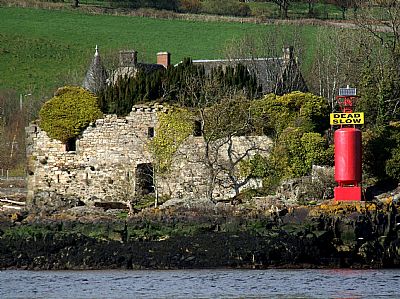
From across the Clyde you can see more of the earlier defensive wall with the later building behind it.
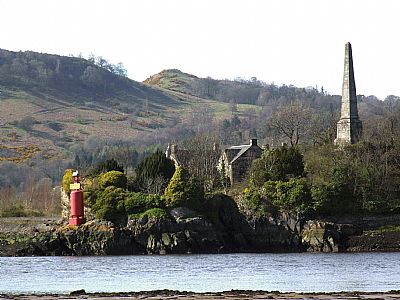
This view from across the Clyde shows the later building behind the earlier stonework and the Bell Memorial obelisk alongside.
With the site so restricted, it is difficult to get decent photographs. Perhaps this situation will change in the future. About 20 years ago the situation was a bit less stringent. The following photos were taken by a Lennox Heritage Society member, Jim McGreggor on an official society outing there in about 2005. You can see some of the members in the pictures. The house had been recently reroofed and was reasonably weathertight.
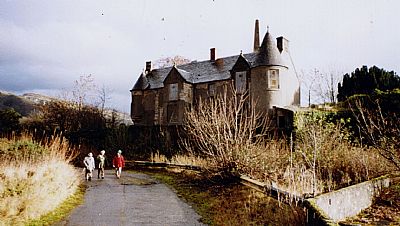
The front of the main house.
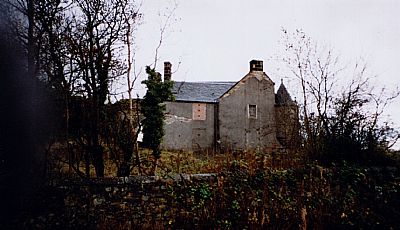
The side of the house.
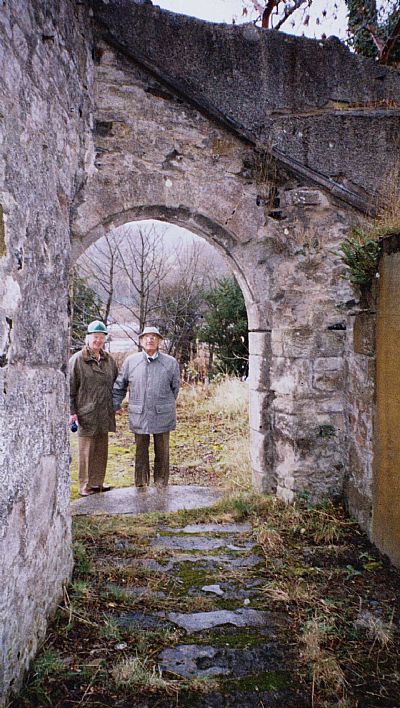
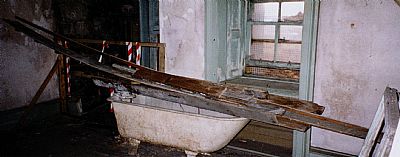
A bath. The loose timber is from the works, mainly to the roof, shortly before this visit.
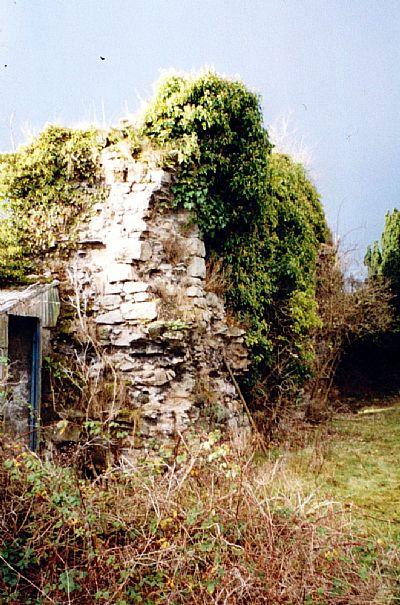
Part of the older castle.
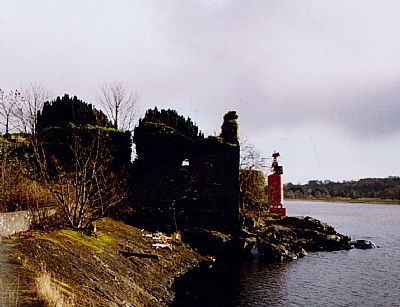
The old castle at the Clyde with the GO SLOW sign and warning light beyond.
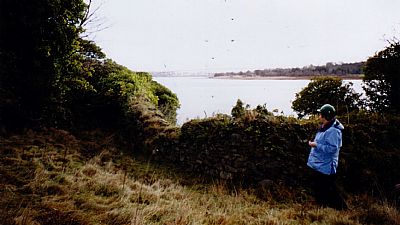
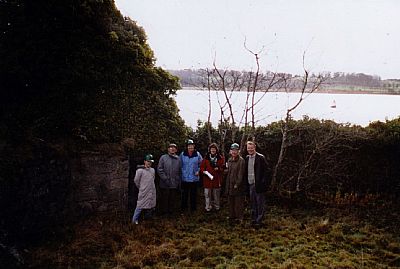
Two views of the boundary walls.
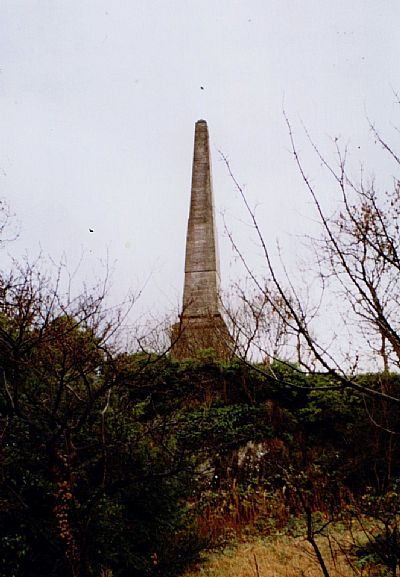
The Bell Memorial obelisk.
ALSO SEE : The HENRY BELL MONUMENT. index.asp?pageid=716286
CROMWELL'S FORT
Although there is absolutely nothing to see anymore, it is of interest to note that a "fort" was built immediately northwest of Dunglass Castle. Canmore simply notes : At Dunglass Horsley records the ruins of a 'modern fort erected there by Oliver Cromwell'. The site is now occupied by a refinery.
RCAHMS visited December 1977, but the illustrations on their (ie HES) website simply show oil tanks. Horsley wrote on the antiquities of Britain in 1732.
It may be wise to take this with a bit of caution. Elsewhere in the same book Horsley suggests that Dunglass Castle may have been built by Cromwellian forces over something that the Romans erected on the same spot. While there may well have been something built at the same time at the spot shown on the Canmore / PastMap map, it is more likely that these forces used the same strategic site on the promontory and then altered it to there needs using some of the original material too. It is known that at times the flatter area to the foreground of Dunglass Castle was used to muster troops and tether their horses. This means that the overall area utilised would have been quite a lot larger than the castle itself and may have included some outbuildings.
AUSTIN-SMITH/LORD : This is a Condition Report including a very comprehensive Historic Research Report submitted as part of the planning application in 2022. https://plandocs.west-dunbarton.gov.uk/my-requests/document-viewer?DocNo=5075936
BRITISH LISTED BUILDINGS : https://britishlistedbuildings.co.uk/200347732-dunglass-castle-old-kilpatrick#.X9aLwnpxdPY
BRUCE, JOHN, History of the Parish of West or Old Kilpatrick and of the Church and certain lands in the Parish of East or New Kilpatrick. 1893. Republished by the Clydebank District Libaries and Museums Department, 1995. ISBN096938112. (Reference above p 215).
BUILDINGS AT RISK REGISTER : https://www.buildingsatrisk.org.uk/details/896833
CANMORE : https://canmore.org.uk/site/43398/dunglass-castle
https://canmore.org.uk/site/43374/dunglass-cromwellian-fort
NATIONAL LIBRARY OF SCOTLAND MAPS : An extracgt frpm NLS map : Dumbartonshire, Sheet XXII
Survey date: 1860, Publication date: 1864 © https://maps.nls.uk/view/228777160
THE THIRD STATISTICAL ACCOUNT OF SCOTLAND : THE COUNTY OF DUNBARTON : Edited editions are available from online sources.
WALKER. FRANK ARNEIL & SINCLAIR, FIONA. North Clyde Clyde Estuary - An Illustrated Architectural Guide. RIAS. 1992. ISBN 1873190 077.
UNIVERSITY OF GLASGOW - Mackintosh Architecture website : https://www.mackintosh-architecture.gla.ac.uk/catalogue/browse/display/?rs=353
WIKIPEDIA : https://en.wikipedia.org/wiki/Talwin_Morris
Thanks to Jim McGreggor's family who donated the collection of photographs of the visit to the castle and house.

